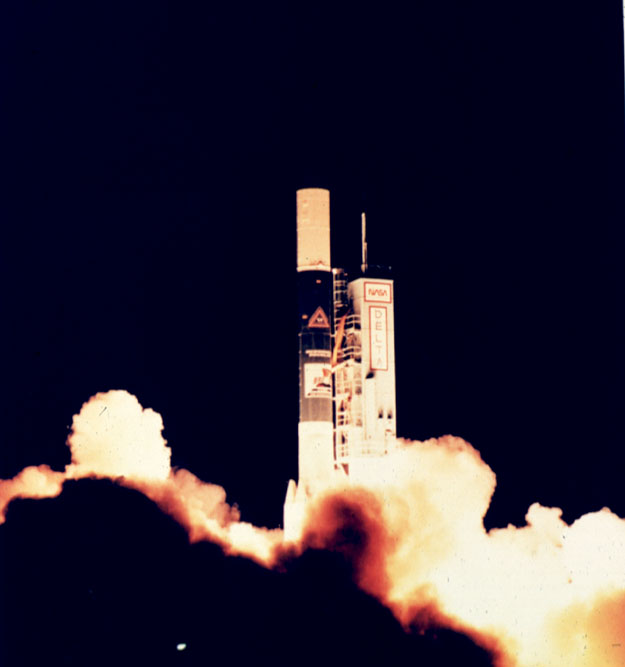|
Compton Spectrometer And Imager
The Compton Spectrometer and Imager (COSI), is a gamma-ray telescope expected to launch in 2025 as a NASA small astrophysics mission. It is intended to study the recent history of star birth, star death, and the formation of chemical elements in the Milky Way. "For more than 60 years, NASA has provided opportunities for inventive, smaller-scale missions to fill knowledge gaps where we still seek answers", said Thomas Zurbuchen, associate administrator for the agency's Science Mission Directorate in Washington, D.C. "COSI will answer questions about the origin of the chemical elements in our own Milky Way galaxy, the very ingredients critical to the formation of Earth itself". COSI will study gamma rays from radioactive atoms produced when massive stars exploded to map where chemical elements were formed in the Milky Way. The mission will also probe the mysterious origin of our galaxy's positrons, also known as antielectrons – subatomic particles that have the same mass as ... [...More Info...] [...Related Items...] OR: [Wikipedia] [Google] [Baidu] |
Explorers Program
The Explorers program is a NASA exploration program that provides flight opportunities for physics, geophysics, heliophysics, and astrophysics investigations from space. Launched in 1958, Explorer 1 was the first spacecraft of the United States to achieve orbit. Over 90 space missions have been launched since. Starting with Explorer 6, it has been operated by NASA, with regular collaboration with a variety of other institutions, including many international partners. Launchers for the Explorer program have included Juno I, Juno II, various Thor, Scout, Delta and Pegasus launch vehicles, and Falcon 9. The program has three classes: Medium-Class Explorers (MIDEX), Small Explorers (SMEX), and University-Class Explorers (UNEX), with select Missions of Opportunity operated with other agencies. History Early Explorer satellites The Explorer program began as a U.S. Army proposal (Project Orbiter) to place a "civilian" artificial satellite into orbit during the International ... [...More Info...] [...Related Items...] OR: [Wikipedia] [Google] [Baidu] |
Galaxy
A galaxy is a system of stars, stellar remnants, interstellar gas, dust, dark matter, bound together by gravity. The word is derived from the Greek ' (), literally 'milky', a reference to the Milky Way galaxy that contains the Solar System. Galaxies, averaging an estimated 100 million stars, range in size from dwarfs with less than a hundred million stars, to the largest galaxies known – supergiants with one hundred trillion stars, each orbiting its galaxy's center of mass. Most of the mass in a typical galaxy is in the form of dark matter, with only a few percent of that mass visible in the form of stars and nebulae. Supermassive black holes are a common feature at the centres of galaxies. Galaxies are categorized according to their visual morphology as elliptical, spiral, or irregular. Many are thought to have supermassive black holes at their centers. The Milky Way's central black hole, known as Sagittarius A*, has a mass four million times greater than the Sun. As o ... [...More Info...] [...Related Items...] OR: [Wikipedia] [Google] [Baidu] |
Germanium Detectors
Germanium is a chemical element with the symbol Ge and atomic number 32. It is lustrous, hard-brittle, grayish-white and similar in appearance to silicon. It is a metalloid in the carbon group that is chemically similar to its group neighbors silicon and tin. Like silicon, germanium naturally reacts and forms complexes with oxygen in nature. Because it seldom appears in high concentration, germanium was discovered comparatively late in the discovery of the elements. Germanium ranks near fiftieth in relative abundance of the elements in the Earth's crust. In 1869, Dmitri Mendeleev predicted its existence and some of its properties from its position on his periodic table, and called the element ekasilicon. In 1886, Clemens Winkler at Freiberg University found the new element, along with silver and sulfur, in the mineral argyrodite. Winkler named the element after his country, Germany. Germanium is mined primarily from sphalerite (the primary ore of zinc), though germanium is a ... [...More Info...] [...Related Items...] OR: [Wikipedia] [Google] [Baidu] |
Compton Scattering
Compton scattering, discovered by Arthur Holly Compton, is the scattering of a high frequency photon after an interaction with a charged particle, usually an electron. If it results in a decrease in energy (increase in wavelength) of the photon (which may be an X-ray or gamma ray photon), it is called the Compton effect. Part of the energy of the photon is transferred to the recoiling electron. Inverse Compton scattering occurs when a charged particle transfers part of its energy to a photon. Introduction Compton scattering is an example of elastic scattering of light by a free charged particle, where the wavelength of the scattered light is different from that of the incident radiation. In Compton's original experiment (see Fig. 1), the energy of the X ray photon (≈17 keV) was significantly larger than the binding energy of the atomic electron, so the electrons could be treated as being free after scattering. The amount by which the light's wavelength changes is called the ... [...More Info...] [...Related Items...] OR: [Wikipedia] [Google] [Baidu] |
Greenbelt, Maryland
Greenbelt is a city in Prince George's County, Maryland, United States, and a suburb of Washington, D.C. At the 2020 census, the population was 24,921. Greenbelt is the first and the largest of the three experimental and controversial New Deal Greenbelt Towns, the others being Greenhills, Ohio, and Greendale, Wisconsin. Greenbelt was planned and built by the Federal government. The cooperative community was conceived in 1935 by Undersecretary of Agriculture Rexford Guy Tugwell, whose perceived collectivist ideology attracted opposition to the Greenbelt Towns project throughout its short duration. The project came into legal existence on April 8, 1935, when Congress passed the Emergency Relief Appropriation Act of 1935. Under the authority granted to him by this legislation, President Franklin D. Roosevelt issued an executive order, on May 1, 1935, establishing the United States Resettlement Administration (RA/RRA). First called ''Maryland Special Project No. 1'', the project ... [...More Info...] [...Related Items...] OR: [Wikipedia] [Google] [Baidu] |
Goddard Space Flight Center
The Goddard Space Flight Center (GSFC) is a major NASA space research laboratory located approximately northeast of Washington, D.C. in Greenbelt, Maryland, United States. Established on May 1, 1959 as NASA's first space flight center, GSFC employs approximately 10,000 civil servants and contractors. It is one of ten major NASA field centers, named in recognition of American rocket propulsion pioneer Robert H. Goddard. GSFC is partially within the former Goddard census-designated place; it has a Greenbelt mailing address.CENSUS 2000 BLOCK MAP: GODDARD CDP " . Retrieved on September 1, 2018. 1990 Census map of Prince ... [...More Info...] [...Related Items...] OR: [Wikipedia] [Google] [Baidu] |
Nobel Prize
The Nobel Prizes ( ; sv, Nobelpriset ; no, Nobelprisen ) are five separate prizes that, according to Alfred Nobel's will of 1895, are awarded to "those who, during the preceding year, have conferred the greatest benefit to humankind." Alfred Nobel was a Swedish chemist, engineer, and industrialist most famously known for the invention of dynamite. He died in 1896. In his will, he bequeathed all of his "remaining realisable assets" to be used to establish five prizes which became known as "Nobel Prizes." Nobel Prizes were first awarded in 1901. Nobel Prizes are awarded in the fields of Physics, Chemistry, Physiology or Medicine, Literature, and Peace (Nobel characterized the Peace Prize as "to the person who has done the most or best to advance fellowship among nations, the abolition or reduction of standing armies, and the establishment and promotion of peace congresses"). In 1968, Sveriges Riksbank (Sweden's central bank) funded the establishment of the Prize in Economi ... [...More Info...] [...Related Items...] OR: [Wikipedia] [Google] [Baidu] |
Cosmic Background Explorer
The Cosmic Background Explorer (COBE ), also referred to as Explorer 66, was a NASA satellite dedicated to cosmology, which operated from 1989 to 1993. Its goals were to investigate the cosmic microwave background radiation (CMB or CMBR) of the universe and provide measurements that would help shape our understanding of the cosmos. COBE's measurements provided two key pieces of evidence that supported the Big Bang theory of the universe: that the CMB has a near-perfect black-body spectrum, and that it has very faint anisotropies. Two of COBE's principal investigators, George F. Smoot and John C. Mather, received the Nobel Prize in Physics in 2006 for their work on the project. According to the Nobel Prize committee, "the COBE project can also be regarded as the starting point for cosmology as a precision science". COBE was the second cosmic microwave background satellite, following RELIKT-1, and was followed by two more advanced spacecraft: the Wilkinson Microwave Anisotropy ... [...More Info...] [...Related Items...] OR: [Wikipedia] [Google] [Baidu] |
Explorer 1
Explorer 1 was the first satellite launched by the United States in 1958 and was part of the U.S. participation in the International Geophysical Year (IGY). The mission followed the first two satellites the previous year; the Soviet Union's Sputnik 1 and Sputnik 2, beginning the Cold War Space Race between the two nations. Explorer 1 was launched on 1 February 1958 at 03:47:56 GMT (or 31 January 1958 at 22:47:56 Eastern Time) atop the first Juno booster from LC-26A at the Cape Canaveral Missile Test Center of the Atlantic Missile Range (AMR), in Florida. It was the first spacecraft to detect the Van Allen radiation belt, returning data until its batteries were exhausted after nearly four months. It remained in orbit until 1970. Explorer 1 was given Satellite Catalog Number 00004 and the Harvard designation 1958 Alpha 1, the forerunner to the modern International Designator. Background The U.S. Earth satellite program began in 1954 as a joint U.S. Army and U.S. Navy pr ... [...More Info...] [...Related Items...] OR: [Wikipedia] [Google] [Baidu] |
Principal Investigator
In many countries, the term principal investigator (PI) refers to the holder of an independent grant and the lead researcher for the grant project, usually in the sciences, such as a laboratory study or a clinical trial. The phrase is also often used as a synonym for "head of the laboratory" or "research group leader". While the expression is common in the sciences, it is used widely for the person or persons who make final decisions and supervise funding and expenditures on a given research project. A co-investigator (Co-I) assists the principal investigator in the management and leadership of the research project. There may be a number of co-investigators supporting a PI. Federal funding In the context of United States federal funding from agencies such as the National Institutes of Health (NIH) or the National Science Foundation (NSF), the PI is the person who takes direct responsibility for completion of a funded project, directing the research and reporting directly to the fun ... [...More Info...] [...Related Items...] OR: [Wikipedia] [Google] [Baidu] |
Positron
The positron or antielectron is the antiparticle or the antimatter counterpart of the electron. It has an electric charge of +1 '' e'', a spin of 1/2 (the same as the electron), and the same mass as an electron. When a positron collides with an electron, annihilation occurs. If this collision occurs at low energies, it results in the production of two or more photons. Positrons can be created by positron emission radioactive decay (through weak interactions), or by pair production from a sufficiently energetic photon which is interacting with an atom in a material. History Theory In 1928, Paul Dirac published a paper proposing that electrons can have both a positive and negative charge. This paper introduced the Dirac equation, a unification of quantum mechanics, special relativity, and the then-new concept of electron spin to explain the Zeeman effect. The paper did not explicitly predict a new particle but did allow for electrons having either positive or negative ... [...More Info...] [...Related Items...] OR: [Wikipedia] [Google] [Baidu] |







